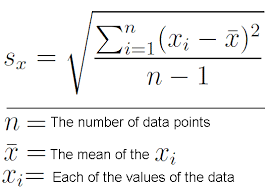When Is the Standard Deviation Equal to Zero Order Instructions: this assignment is due on next week Wednesday, so can it be ready before next week Wednesday at 10 am, please.

When Is the Standard Deviation Equal to Zero Sample Answer
The z-score shows the dispersion from the mean. It is computed using the following formula.
z-score =
Given x = 9, μ =10, and σ = 4. So,
z-score =
The population standard deviation of 0, 4, and 5 is calculated as follows:
s.d =
Thus, we need to obtain the mean =
S.d =
=
The minimum is the observation with the least value in a sample, and the maximum is the largest number. Since the observations 1, 1, 2, 3, 5, 8, 13, 21, 34, 55, 89, 144, 233 are arranged in ascending order, the first observation is the minimum and the last maximum.
Minimum = 1
Maximum = 233
To obtain the first quarter (25%) we multiply the number of observations (n = 13) by 25%.
= =0.25*13 = 3.25
Thus, the 4th observation is the first quarter.
First quarter = 3
The median is the observation at the center/middle (13/2 = 6.5 = 7th observation)
Median = 13
Upper quartile = 0.75*13 = 9.95 = 10th observation
Upper quartile = 89
Inter-quartile range =upper quartile – lower quartile
= 89 – 3
= 86
A standard deviation of zero deduces that the data sample are not spread, which in other words means that they are clumped around a single value (Taylor, 2015).
It is expected that about 95% of the observations to lie between 2 standard deviations of the mean.
It is anticipated that about 98.8% of the observations to lie between 2.5 standard deviations of the average.
Normally distributed means that the population distribution has a bell-shaped density curve, which can be described by its mean (average) and standard deviation. Furthermore, the density curve is symmetrical, clustered around the mean, and the standard deviation determines the spread of the plot.
P (x < 60000) = z () =
P (x < 60000) = 0.8413
Therefore, 84.13% of people have salaries of $60,000or less.
P (x < 40000) = z () =
=
=
= 0.1587
Therefore, 15.87% of people have salaries of $40,000or less.
When Is the Standard Deviation Equal to Zero References
Taylor, C. (2015). When Is the Standard Deviation Equal to Zero? Retrieved July 16, 2016, from http://statistics.about.com/od/Mathstat/fl/When-Is-the-Standard-Deviation-Equal-to-Zero.htm




